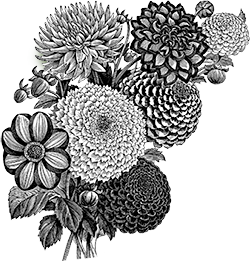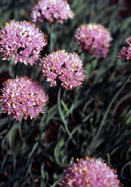Though preservation is our mission, bulbs drop out of our catalog every year.
Sometimes it’s because the harvest was too small. Sometimes it’s because they’re widely available elsewhere and don’t need our help. And sometimes it’s because we’ve lost our only known source due to severe weather (cold, drought, etc.), health problems (a debilitating stroke), or economic woes (small farmers are always at risk).
The good news is that, in time, we’re often able to return these bulbs to our catalog. So here’s a list of many we’ve offered in the past. For an alert the moment they’re available again, subscribe to our free email newsletter. Or to find a similar bulb, try our easy Advanced Bulb Search.
|
|
|
|
|
|
|
This cute little allium gets its name from its tufts of short, flat, blue-green leaves that are “curiously twisted like a corkscrew” (The Garden, 1875). In her 1936 Adventures with Hardy Bulbs, Louise Beebe Wilder praised not only its foliage but its “very decorative” buds and mauve flowers which open in late summer and look especially “nice in combination with Sedum sieboldii.” 6-10”, zones 4a-7b(8bWC), from Michigan. Last offered in 2010. Widely available elsewhere.
|
|
|
|
You can protect your home from witches with this ancient allium, or just enjoy its starry yellow umbels blooming with the first iris. It’s been a favorite in country gardens for centuries, and as Louise Beebe Wilder wrote, “Miss Jekyll admired and grew it, and that in itself is enough to give it a place in the best society.” Lily leek, yellow moly. 8-12”, zones 4a-7b. Last offered in 2006. Widely available elsewhere.
|
|
|
|
This white form of the wild, mostly blue original (see above) was introduced in 1950, won the RHS Award of Garden Merit in 1993, and, to quote Christopher Lloyd, is both “the strongest growing” and “dazzling.” Blooms and naturalizes best in bright shade, 5-8”, zones 5a-8a(9bWC), from Holland.
Last offered in 2023. If you’d like to be notified the next time we offer this treasure, click to sign up for an email alert.
|
|
|
|
The intrepid Lewis and Clark were awed by meadows full of this glorious Northwest native. It’s tall and easy to grow (though not for dry sites), with spikes of starry, blue-purple, late-spring flowers that bees love. 3 feet, zones 4a-7b(9bWC), from Holland.
Last offered in 2008. If you’d like to be notified the next time we offer this treasure, click to sign up for an email alert.
|
|
|
|
If these extra-early cups of sunshine have failed you, try ours! Blooming even earlier than snowdrops, they multiply eagerly in light shade (their seeds are spread by ants) and are so animal-proof that the Elizabethans called them Little Yellow Woolfes-bain. 3-5”, zones 5a-7b(8bWC), from Holland.
Last offered in 2024. If you’d like to be notified the next time we offer this treasure, click to sign up for an email alert.
|
|
|
|
This rarely-offered native of our eastern woodlands is neither a violet nor a lily — nor any of the common European or West Coast hybrids — but it is exquisite. Its graceful yellow flowers nod above hauntingly beautiful leaves of milk-green dappled with brown, the inspiration for one of its many names, trout lily. One caveat, though: even our top-size bulbs may not bloom their first year, and though they’ll multiply eagerly, their offspring will take years to reach blooming-size. Aka adder’s tongue, amberbell, fawn lily, 7-10”, part shade, zones 3a-7b(8bWC), nursery-grown for us in Tennessee.
Last offered in 2014. If you’d like to be notified the next time we offer this treasure, click to sign up for an email alert.
|
|
|
|
In 1629 Parkinson put this tall, dramatic flower on page 1 of his mammoth florilegium, noting that “for its stately beautifulness, [it] deserveth the first place.” Brought to America by the early colonists, they became so popular that by 1820 the Prince nursery of Long Island was offering 22 different kinds. Best in rich, very well-drained soil. 3-4 feet, zones 5a-7b(8bWC), from Holland. Last offered in 2013. Widely available elsewhere.
|
|
|
|
Strange and stylish, this great fritillary has been in US gardens since at least 1830. Angular, dusky-purple bells cluster on 24-40 inch stems over wavy sage green leaves — very Japanesque. Give it full sun/part shade in rich, well-drained soil. Zones 5b-7b, from Holland. Last offered in 2003. Widely available elsewhere.
|
|
|
|
Crown imperials are woefully under-appreciated today. Yellow ones like ‘Lutea’ grew in Williamsburg by 1739, and the Prince nursery of Long Island listed 22 different kinds in 1830. Their height is dramatic, their skunky smell soon fades (we actually like it), and our bulbs are big and superb. To get them to return, give them well-drained soil. 3-4 feet, zones 5a-7b. Holland. Last offered in 2002. Widely available elsewhere.
|
|
|
|
One of the most popular snowdrops for over a century, this strong-growing beauty holds its flowers on unusually long pedicels which, in the words of the great E.A. Bowles, “causes them to swing to and fro in a slight breeze,” making it especially graceful and “easily recognized even from a distance.” It’s been a couple years since we last offered this treasure, so get it while you can! 5-7”, zones 3a-7a(8aWC), from Holland.
Last offered in 2024. If you’d like to be notified the next time we offer this treasure, click to sign up for an email alert.
|
|
|
|
Voted best of all by experts at an RHS conference in 2004, ‘S. Arnott’ was sent by Scotsman Sam Arnott to collector Henry Elwes sometime before 1922. It’s a “tall, handsome, well-proportioned chap with attractively rounded blooms,” writes Naomi Slade in The Plant Lovers Guide to Snowdrops. It’s “very easy to grow” and “increases reliably,” and its “sweet strong scent” makes it “a great cut flower.” Aka ‘Sam Arnott’, 8-10”, zones 4b-7b(9bWC), from Holland.
Last offered in 2024. If you’d like to be notified the next time we offer this treasure, click to sign up for an email alert.
|
|
|
|
An icon of spring for centuries, this beloved woodland wildflower seems to be born from the melting snow. Its brave little bells ring in the spring well before crocus, animals leave it alone, and it multiplies without care in light shade. In other words, it’s a springtime essential! 5-6”, zones 3a-7a(8aWC), from Holland. Last offered in 2016. We may offer it again periodically.
Last offered in 2016. We offer a rotating selection of snowdrops. If you’d like to be notified the next time we offer this treasure, click to sign up for an email alert.
|
|
|
|
For 400 years this was the grape hyacinth, but today it has all but disappeared from the bulb trade, shoved aside by the modern M. armeniacum. What a loss! It’s cold-hardier and — maybe best of all — bluer than armeniacum, much more vigorous than its wimpy white form ‘Album’, and its leaves are upright and blissfully sprawl-free. 6-8”, zones 3a-7b(9bWC), from Holland. Last offered in 2012. Sadly this 400-year-old garden classic has gone “commercially extinct” in the Netherlands. We’re searching for another source, so please keep your fingers crossed!
|
|

























